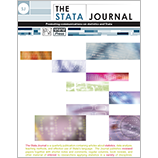General-to-specific modeling in Stata
Damian Clarke
Department of Economics
University of Oxford
Oxford, UK
[email protected]
|
Abstract. Empirical researchers are frequently confronted with issues regarding
which explanatory variables to include in their models. This article describes the
application of a well-known model-selection algorithm to Stata: general-to-specific
(GETS) modeling. This process provides a prescriptive and defendable way of
selecting a few relevant variables from a large list of potentially important variables
when fitting a regression model. Several empirical issues in GETS modeling are
then discussed, specifically, how such an algorithm can be applied to estimations
based upon cross-sectional, time-series, and panel data. A command is presented,
written in Stata and Mata, that implements this algorithm for various data types
in a flexible way. This command is based on Stata’s regress or xtreg command, so
it is suitable for researchers in the broad range of fields where regression analysis
is used. Finally, the genspec command is illustrated using data from applied
studies of GETS modeling with Monte Carlo simulation. It is shown to perform
as empirically predicted and to have good size and power (or gauge and potency)
properties under simulation.
View all articles by this author:
Damian Clarke
View all articles with these keywords:
genspec, model selection, general to specific, statistical analysis, specification tests
Download citation: BibTeX RIS
Download citation and abstract: BibTeX RIS
|
